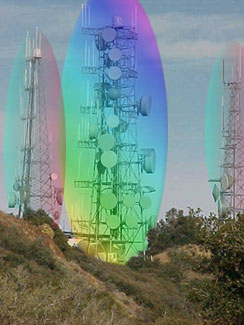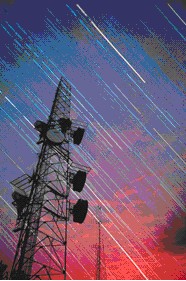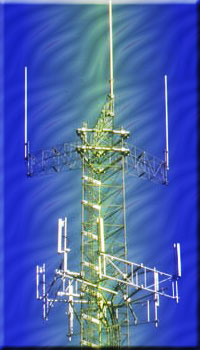|
2006 General Assembly nod could see other states adopting NC radiation standard 
UPDATE: STANDARD HAS BEEN APPROVED AND IS EFFECTIVE JULY 28, 2006.
May 1, 2005 -- The non-ionizing radiation standard drafted by North Carolina Department of Labor officials and stakeholders, and approved by the Rules Review Commission will not be reviewed by the State Legislature until the 2006 session. It would have been promulgated this year, but it was submitted too late to be reviewed during the 2005 session. Although there is no house bill in place to disapprove it, it is not without its opponents.
The North Carolina Association of Broadcasters and the North Carolina Cable Telecommunications Association believe the rules could interfere with routine activities where there is not a risk of a serious injury or death. The Personal Communications Industry Association (PCIA) and other industry groups believe that the proposed exposure standard appears to exceed existing standards. Although this standard is just for the State of North Carolina, the telecommunications associations are aware that other states may quickly adopt the North Carolina language within their state’s standards once there is a resolution. The North Carolina Rules Review Commission approved the rewritten rule submitted by the Department of Labor. At least ten letters requesting legislative review were received. The standard could become effective in January or February of 2006.
Although this standard is just for the State of North Carolina, the telecommunications associations are aware that other states may quickly adopt the North Carolina language within their state’s standards once there is a resolution. Almost half of the nation’s states have their own safety and health programs. OSHA approves and monitors the State OSH plans. See: States with OSH programs .
EFFECTIVE: July 28, 2006 
CHAPTER 7 - OFFICE OF OCCUPATIONAL SAFETY AND HEALTH
SUBCHAPTER 07F - STANDARDS
SECTION .0600 – COMMUNICATION TOWER STANDARDS
13 NCAC 07F .0606 NON-IONIZING RADIATION
(a) General. Employers shall ensure that employees performing work on communication towers are not exposed to Radio Frequency (RF) Electromagnetic Fields in excess of the Federal Communications Commission (FCC) maximum permissible exposure (MPE) limits for exposure as prescribed in 47 CFR 1.1310.
(b) Protection from Radiation Exposure.

(1) Employees shall not enter areas where RF exposure levels are above the general population/uncontrolled MPE's described in 47 CFR 1.1310 unless they understand the potential for exposure and can exercise control over the exposure.
(2) Control Procedures. Prior to employees performing work in areas on a communication tower where RF exposure levels exceed the occupational/controlled MPE values stated in 47 CFR 1.1310, the employer shall enact and enforce written control procedures that provide for the reduction, elimination, avoidance or protection from such RF levels. These written control procedures shall include the following:
(A) Reducing the transmitter power to a level that ensures RF exposure levels in areas where employees are working do not exceed the occupational/controlled MPE values stated in 47 CFR 1.1310, and that the transmitter power level is not increased until all employees have ceased working in those areas. If this method is chosen, the transmitter power shall be locked out and tagged out at the reduced level by a competent person in accordance with 29 CFR 1910.147. Prior to removing lock out/tag out devices and restoring the original transmitter power level, all employees shall be notified and the work area shall be checked to ensure that all employees have been safely positioned and removed;
(B) If the transmitter power level in areas where employees are working cannot be reduced and maintained at a level that ensures RF exposure levels do not exceed the occupational/controlled MPE values stated in 47 CFR 1.1310, the transmitter power shall be locked out and tagged out by a competent person in accordance with 29 CFR 1910.147. Prior to removing lock out/tag out devices and restoring the transmitter power level, all employees shall be notified and the work area shall be checked to ensure that all employees have been safely positioned and removed;
(C) If the transmitter power level can not be reduced or eliminated, an employer may permit its employees to access areas where the occupational/controlled MPE values stated in 47 CFR 1.1310 are exceeded if it implements engineering or administrative controls that comply with the FCC's regulations concerning such exposure, including limiting the duration of the exposure and utilizing monitoring equipment, RF protective clothing and other related PPE; or
(D) If an employer cannot ensure that the conditions in Parts (A), (B) or (C), of this Subparagraph, are met, employees shall not be permitted to access areas where RF exposure levels exceed the occupational/controlled MPE values stated in 47 CFR 1.1310.
 (c) Use of Controls. Prior to commencing work on a communication tower, a competent person shall assess potential RF hazards of areas which may be accessed by employees in the course of their work, and post temporary signage to indicate areas where the RF hazard exceeds the general population/uncontrolled MPE limits for exposure set forth in 47 CFR 1.1310 . Temporary signage shall remain in place while work is performed and the hazard exists. (c) Use of Controls. Prior to commencing work on a communication tower, a competent person shall assess potential RF hazards of areas which may be accessed by employees in the course of their work, and post temporary signage to indicate areas where the RF hazard exceeds the general population/uncontrolled MPE limits for exposure set forth in 47 CFR 1.1310 . Temporary signage shall remain in place while work is performed and the hazard exists.
(d) RF Safety Program. When employees are exposed to RF fields in excess of the general population/uncontrolled MPE limits established in 47 CFR 1.1310 as a consequence of their employment, the employer  shall develop, implement, and maintain a written safety and health program with site specific procedures and elements based on the electromagnetic radiation hazards present, in accordance with 13 NCAC 07F .0609(g). shall develop, implement, and maintain a written safety and health program with site specific procedures and elements based on the electromagnetic radiation hazards present, in accordance with 13 NCAC 07F .0609(g).

Copyright © 2005 Wireless Estimator, Inc. Please request reprint permission.
|